 Last additions - Lake Biwa Rowing Song 琵琶湖周航の歌 英語版 Last additions - Lake Biwa Rowing Song 琵琶湖周航の歌 英語版 |

Imazu shoreMar 23, 2007
|
|

Imazu road along the lake shore, near Chojiya inn.Mar 23, 2007
|
|

Kyoto University Rowing Club arrive at Omi-Maiko in Aug. 2006 during their annual Lake Biwa rowing trip.Mar 23, 2007
|
|

Verse 1 Lyrics (Otsu) 一番の英訳(大津). School logo on boat house, a cherry blossom with three stripes for Dai-san Koto Gakko.We're children of the lake, off to wander 'round.
This journey fills my heart with, intense happiness.
Rising mist evaporates, ripples come and go.
Shiga's Miyako dear, bid farewell for now.
われは湖の子 さすらいの
旅にしあれば しみじみと
のぼる狭霧や さざなみの
志賀の都よ いざさらば
Ware wa Umi no Ko, sasurai no
tabi ni shiareba, shimijimi to
Noboru sagiri ya, sazanami no
Shiga no Miyako yo, iza saraba
--
This first verse refers to the start of the journey of life. The lake mist symbolizes the uncertainty of what lies ahead.
The capital of Shiga is Otsu, where they departed from Mihogasaki boat harbor on June 27, 1917. For some reason, the kanji characters for "Shiga" is incorrect for Shiga Prefecture. Mar 23, 2007
|
|

Mar 23, 2007
|
|

Jamie won the speech contest. Her award certificate from Shiga Governor Kada Yukiko. 第3回BNN外国人による日本語スピーチ大会 最優秀賞を受賞!Mar 14, 2007
|
|

Title of her speech was, Biwako Shuko no Uta no Boken (Adventures with Lake Biwa Rowing Song). 「琵琶湖周航の歌」の冒険Mar 14, 2007
|
|

After the awards ceremony, she was asked to sing a little bit of the English song she talked about. She beautifully sang the first verse and drew much applause.Mar 14, 2007
|
|

Feb. 25, 2007 Jamie Lee Thompson gives her speech at the 3rd Biwako Nihongo Network's Japanese Speech Contest by Foreigners.Mar 14, 2007
|
|

Mar. 4, 2007 Nakamura Naoko sings "Lake Biwa Rowing Song" at Canora Hall in Okaya, Nagano Pref.Mar 14, 2007
|
|

The first Japanese person to sing the English song in public. This was at the Okaya International Exchange Association's 15th anniversary festival.Mar 14, 2007
|
|

Nakamura Naoko sings "Lake Biwa Rowing Song" up to verse 3.Mar 14, 2007
|
|

The first person to sing the English song in public outside Shiga.Mar 14, 2007
|
|
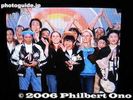
Everyone waving goodbye at the end of the show. Singer Fuji Ayako on the extreme right.Mar 14, 2007
|
|
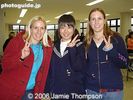
The twins pose with the high school girl who went on to be the show's Champion.Mar 14, 2007
|
|
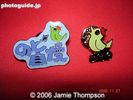
Nodo Jiman for those who made it to the preliminary screening.Mar 14, 2007
|
|

Small trophy for those who appeared on the TV program. (Photo by Jamie Thompson)Mar 14, 2007
|
|
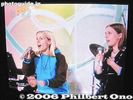
Nov. 26, 2006 Jamie and Megan Thompson sing "Lake Biwa Rowing." (verse 1 only) on the NHK TV Nodo Jiman amateur singing show.Mar 14, 2007
|
|
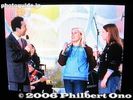
The twins talk with the host of the 61-year-old TV program. NHKのど自慢出場、合格Mar 14, 2007
|
|
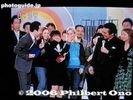
The show's Champion is announced. This high school girl from Takamatsu, Kagawa Pref.Mar 14, 2007
|
|
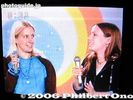
Megan: "And Japan's nature is also beautiful..." This show was broadcast live from Mitoyo, Kagawa Pref., near Megan's town.Mar 14, 2007
|
|

As if drawn to the singing, the floating school named "Uminoko" (Child of the Lake) also docked at the same time.Mar 14, 2007
|
|

June 3, 2006 Jamie and Megan Thompson sing "Lake Biwa Rowing Song" at Imazu Port, Shiga Pref.Mar 14, 2007
|
|
|

This was the first time the English song was sung in public. 「琵琶湖周航の歌」英語版の発表会、今津港の歌碑前Mar 14, 2007
|
|
|
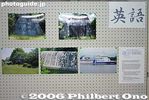
Verse 1 song monument photos (Otsu)Mar 13, 2007
|
|
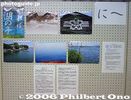
Verse 1 photos (Otsu)Mar 13, 2007
|
|

Verse 2 song monument photos (Omi-Maiko)Mar 13, 2007
|
|
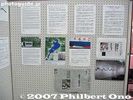
Exhibition introductionMar 13, 2007
|
|
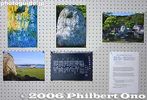
Verse 6 song monument photos (Chomeiji)Mar 13, 2007
|
|

Photos of the song monument and Taro Oguchi statue in Okaya, Nagano, his hometown.Mar 13, 2007
|
|

Below the photos were explanation of the song and English lyrics.Mar 13, 2007
|
|

Right panel.Mar 13, 2007
|
|

Some English explanations also provided.Mar 13, 2007
|
|

Title: Lake Biwa Rowing Song in English 「琵琶湖周航の歌」英語版Mar 13, 2007
|
|

My photo exhibition with two panels showing photos of places mentioned in the song and song monuments.Mar 13, 2007
|
|

Left panel.Mar 13, 2007
|
|

Okaya One-Day Exhibition, Mar. 4, 2007 at Canora Hall, Okaya, Nagano.Mar 13, 2007
|
|
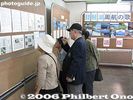
Mar 13, 2007
|
|
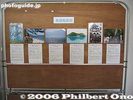
Explanation of English lyrics for the six verses.Mar 13, 2007
|
|
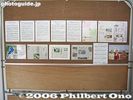
Introduction to the song and newspaper articlesMar 13, 2007
|
|
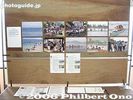
Photos of Kyoto University Rowing Club's Lake Biwa rowing trip, including a picture of them posing with the Chomeiji song monument.Mar 13, 2007
|
|
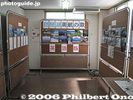
Title: Lake Biwa Rowing Song in English 「琵琶湖周航の歌」英語版Mar 13, 2007
|
|
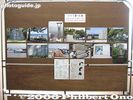
Photos of song monuments.Mar 13, 2007
|
|
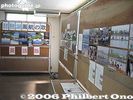
Two panels on right wallMar 13, 2007
|
|

Mar 13, 2007
|
|
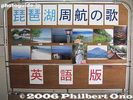
Center exhibition panel with song location imagesMar 13, 2007
|
|
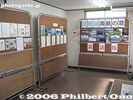
Two panels on left wallMar 13, 2007
|
|

Photo exhibition panelsMar 13, 2007
|
|

Entrance to my photo exhibition in Shima Kominkan Public Hall during their day-long Bunka-sai Culture Festival.Mar 13, 2007
|
|
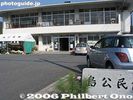
Omi-Hachiman One-Day Exhibition, Oct. 29, 2006 at Shima Kominkan Public Hall, Omi-Hachiman, Shiga. 島公民館文化祭Mar 13, 2007
|
|
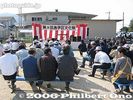
Opening ceremony for the Culture Festival (Bunka-sai) at this public hall near Chomeiji temple in Omi-Hachiman.Mar 13, 2007
|
|

The photos displayed were almost the same as the Imazu exhibition.Mar 13, 2007
|
|

Title: Lake Biwa Rowing Song - Sing in English! 「琵琶湖周航の歌」英語で歌おう! Entrance to Biwa Library.Mar 13, 2007
|
|

Mar 13, 2007
|
|

Photo exhibition panels at Biwa LibraryMar 13, 2007
|
|

Photo exhibition panels at Biwa LibraryMar 13, 2007
|
|

Photo exhibition in Biwa LibraryMar 13, 2007
|
|
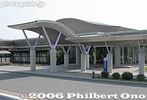
Biwa Library びわ図書館Mar 13, 2007
|
|

Photo exhibition in Biwa Library, Nagahama, Shiga Pref.Mar 13, 2007
|
|

Verse 2 photos (Omi-Maiko)Mar 13, 2007
|
|

Lute Plaza, which includes Biwa Library in Nagahama, Shiga. 20-min. bus ride from Nagahama Station.Mar 13, 2007
|
|
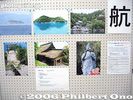
Verse 4 photos (Chikubushima)Mar 13, 2007
|
|

Nagahama Exhibition, July 1 - Aug. 10, 2006 at Biwa Library, Nagahama, Shiga Prefecture. Exhibition poster.Mar 13, 2007
|
|

Verse 3 song monument photos (Imazu)Mar 13, 2007
|
|
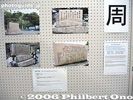
Verse 4 song monument photos (Chikubushima)Mar 13, 2007
|
|
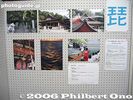
Verse 6 photos (Chomeiji)Mar 13, 2007
|
|
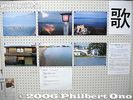
Verse 3 photos (Imazu)Mar 13, 2007
|
|

Crowd gathersMar 13, 2007
|
|

Exhibition room on the 2nd floor of the Biwako Shuko no Uta Shiryokan song museum.Mar 13, 2007
|
|
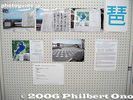
Verse 5 song monument photos (Hikone)Mar 13, 2007
|
|
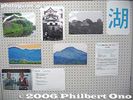
Verse 5 photos (Hikone)Mar 13, 2007
|
|

Imazu Exhibition, May 16 - June 25, 2006 at Biwako Shuko no Uta Shiryokan, Takashima, Shiga. Photo exhibition poster.Mar 13, 2007
|
|

Title: Lake Biwa Rowing Song - In Pictures and in English 「琵琶湖周航の歌」写真と英語に. Entrance to exhibition room in the song museum, Imazu.Mar 13, 2007
|
|

Mar 13, 2007
|
|
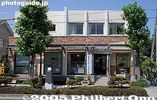
Biwako Shuko no Uta Shiryokan song museum, in Imazu, Shiga 琵琶湖周航の歌資料館Mar 13, 2007
|
|

Verse 4 photos (Chikubushima)Mar 13, 2007
|
|

On the adjacent wall, I showed a map of the rowing route, artist's message in English and Japanese, and an English biography of Taro Oguchi, the songwriter.Mar 13, 2007
|
|

Verse 6 photos (Chomeiji)Mar 13, 2007
|
|

Verse 5 photos (Hikone)Mar 13, 2007
|
|

Verse 1 photos (Otsu)Mar 13, 2007
|
|

Verse 3 photos (Imazu)Mar 13, 2007
|
|

Verse 2 photos (Omi-Maiko)Mar 13, 2007
|
|

For each verse (total 6 verses), I showed three photos and a caption sheet with my non-singable English translation of the verse.「琵琶湖周航の歌」をイメージ写真付きで英訳された作詞と英文説明で紹介する写真展です。歌に登場する各地の写真や6番まですべての歌碑も英語で紹介。外国人も知って欲しい名曲です。英語の勉強にも!
2005年11月21日(月)〜12月4日(日) 9:30〜17:00
滋賀県大津市 滋賀会館 文化サロンギャラリー 入場無料
〒520-0044 大津市京町三丁目 4-22
Tel: 077-525-9995
HP: http://www.shiga-bunshin.or.jp/shigakaikan/
アクセス:
JR大津駅びわ湖口(北口)から徒歩5分
京阪浜大津駅からバス7分
名神大津インターからバス5分
京阪島ノ関駅から徒歩3分
1971年に加藤登紀子の大ヒットになったこの「琵琶湖周航の歌」は、昨年までに僕は聞いたことない。昨年の春に長野県諏訪市の御柱祭りを見に行ったときに岡谷市に泊まって近くの諏訪湖で散歩すると歌の作詞家である小口太郎(岡谷出身)の銅像があって「琵琶湖周航の歌」が紹介されて非常に興味深いものと思った。
英語で紹介したいなと思ってこの歌の英語版とイメージ写真をやっと完成しました。そしていつかこの歌を英語で歌ってもらいたい。歌詞を英語にすることはあまり難しくないが、それを歌のメロディに合わせることが大変。まだそこまで完成していない。もっと時間が必要。できあがったら、勿論また発表します。
この文化サロンは、サロン形の喫茶店になっている。Mar 13, 2007
|
|

My first and very small exhibition to introduce "Lake Biwa Rowing Song" in English. The English lyrics were still unfinished, so only an English translation was presented.I showed three images per verse (6 verses total), plus caption sheets and artist's message, boating map, and composer's biography on the other wall.
All the pictures were printed on A4 inkjet paper. Very low budget exhibition, but it caught the interest of one newspaper reporter. I later changed the song title to "Lake Biwa Rowing Song."
Exhibition Date & Time: Nov. 21 to Dec. 4, 2005, 9:30 am to 5:00 pm, closed Mon.
Map: http://www.shiga-bunshin.or.jp/shigakaikan/map.html
Address: Kyomachi 3-4-22, Otsu, Shiga Pref.
Phone: 077-525-9995
〒520-0044 大津市京町三丁目 4-22
Web site: http://www.shiga-bunshin.or.jp/shigakaikan/Mar 13, 2007
|
|

Title: Lake Biwa Rowing Song - In Pictures and in English Bunka Salon Gallery (also a coffee shop) inside Shiga Kaikan. 「琵琶湖周航の歌」〜写真と英語に〜The title was "Lake Biwa Boating Song - In Pictures and in English." I later changed the song title to "Lake Biwa Rowing Song."
Shiga Kaikan has two spaces for exhibitions, and I used the smaller space called Bunka Salon Gallery.
One entire wall and half of another wall were available for exhibitions free of charge.Mar 13, 2007
|
|

Otsu Exhibition, Nov. 21 - Dec. 4, 2005 at Shiga Kaikan, Otsu, Shiga. Right across from the Shiga Prefectural Office. 滋賀会館For this exhibition, I created my own photographic rendition of the places and scenes mentioned in the song and also photographed all the stone monuments dedicated to the song. I used Photoshop to composite images and to alter the colors into a dreamy condition as the song suggests. I also translated the lyrics into English.
The exhibition was held at Shiga Kaikan, right across from the Shiga Prefectural Office. Shiga Kaikan has two spaces for exhibitions, and I used the smaller space called Bunka Salon Gallery.
Map: http://www.shiga-bunshin.or.jp/shigakaikan/map.html
Address: Kyomachi 3-4-22, Otsu, Shiga Pref.
Phone: 077-525-9995
〒520-0044 大津市京町三丁目 4-22
Web site: http://www.shiga-bunshin.or.jp/shigakaikan/Mar 13, 2007
|
|

Verse 3 Lyrics (Imazu) 三番の英訳(今津) "We drift from wave to wave..."We drift from wave to wave, straying aimlessly.
On shore we see red fire, brings back memories.
With our sights set nowhere, rolling with the waves.
Today is Imazu or, Nagahama huh.
浪のまにまに 漂えば
赤い泊火 懐かしみ
行方定めぬ 浪枕
今日は今津か 長浜か
Nami no mani mani, tadayoeba
Akai tomaribi, natsukashimi
Yukue sadamenu, nami makura
Kyo wa Imazu ka, Nagahama kaMar 13, 2007
|
|
|

"Golden waves on which we weave..."Mar 13, 2007
|
|

"Tell us my friends your stories, with your fervent hearts."Mar 13, 2007
|
|

Golden wavesMar 13, 2007
|
|

Stone monument for Verse 6Mar 13, 2007
|
|

Chomeiji worships the Kannon goddess of long life and good health. "Chomeiji" literally means "Long Life Temple." See more photos of Chomeiji Temple here.Mar 13, 2007
|
|

Regatta on Lake BiwaMar 13, 2007
|
|

Chomeiji, 31st temple on the Saigoku Pilgrimage CircuitMar 13, 2007
|
|
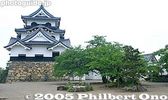
More photos of Hikone Castle here.The castle tower is a National Treasure. Hikone Castle is one of only five castle towers in Japan designated as National Treasures. (The others being Himeji, Inuyama, Matsumoto, and Matsue Castles. Nijo Castle in Kyoto is also a National Treasure, but it does not have a castle tower.)
See more photos of Hikone Castle here.Mar 13, 2007
|
|

"Dispel this world's impureness, very faraway."Mar 13, 2007
|
|

"Saigoku pilgrimage, Chomeiji."Mar 13, 2007
|
|
|
|

"Abundant summer grasses, a moat still remains"Mar 13, 2007
|
|

Verse 5 Lyrics (Hikone) 五番の英訳(彦根)Sharp arrows buried deeply, way into the ground.
Abundant summer grasses, a moat still remains.
Standing in an old castle, all alone oneself.
Hira and Ibuki too, only but a dream.
矢の根は 深く埋もれて
夏草しげき 堀のあと
古城にひとり 佇めば
比良も伊吹も 夢のごと
Ya no ne wa, fukaku uzumorete
Natsukusa shigeki, hori no ato
Kojo ni hitori, tatazumeba
Hira mo Ibuki mo, yume no goto
--
This is the only verse where the setting is not specifically mentioned. The only hint is "old castle," which must be either Nagahama Castle or Hikone Castle. It is likely that it is Hikone Castle with its authentic castle tower and moats.
See more photos of Hikone here.Mar 13, 2007
|
|

Verse 6 Lyrics (Chomeiji) 六番の英訳(長命寺)Saigoku pilgrimage, Chomeiji.
Dispel this world's impureness, very faraway.
Golden waves on which we weave, rowing all we can.
Tell us my friends your stories, with your fervent hearts.
西国十番 長命寺
汚れの現世 遠く去りて
黄金の波に いざ漕がん
語れ我が友 熱き心
Saigoku Juban, Chomeiji
Kegare no utsushiyo, tooku sarite
Kogane no nami ni, iza kogan
Katare wagatomo, atsuki kokoro
--
This verse is said to refer to the Pure Land of Buddhism. The song has strong Buddhist overtones, but interestingly the melody happens to be based on a Christian hymn. Chomeiji was a lunch stop before they rowed back to Otsu.
See more photos of Chomeiji Temple here.Mar 13, 2007
|
|
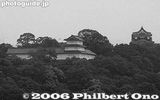
Hikone CastleMar 13, 2007
|
|

Buddha statue on ChikubushimaMar 13, 2007
|
|

"Azure blue flower garden, revered coral shrine."Mar 13, 2007
|
|

"Full of old-time stories, Chikubushima."The island has a complex of temples named Hogonji. It belongs to the Shingon Buddhist Sect (Buzan School). It is said that it was first built in 724. It is also the 30th temple in the 33 Temple Pilgrimage of Saigoku (Western Japan).
See more photos of Chikubushima here.Mar 13, 2007
|
|
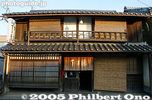
Chojiya ryokan inn, Imazu. This is probably the inn where Taro Oguchi and crew stayed in Imazu and created the song in 1917. 丁子屋It is along the lake shore and still in business today.
It was on June 28, 1917 in Imazu, after dinner on the second day of their rowing trip, when a boatmate named Jiro Nakayasu exclaimed, "Hey everyone, listen up! Oguchi has written this song," and showed everyone the song. Then another boatmate named Taniguchi, who knew a popular song called Hitsuji Kusa (Water Lilies), began singing Oguchi's lyrics to the melody. Since the melody went well with the words, the seven boat crewmates sang the song together that night. It was the birth of the Lake Biwa Rowing Song. The boys worked on the song further and sang it while rowing.
See more photos of Imazu here.Mar 13, 2007
|
|

Broken dishes near the toriiMar 13, 2007
|
|
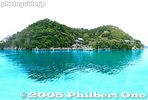
Verse 4 Lyrics (Chikubushima) 四番の英訳(竹生島)Azure blue flower garden, revered coral shrine.
Full of old-time stories, Chikubushima.
In the hands of Buddha, one young maiden lies.
She's sleeping in compassion, resting peacefully.
瑠璃の花園 珊瑚の宮
古い伝えの 竹生島
仏の御手に いだかれて
ねむれ乙女子 やすらけく
Ruri no hanazono, sango no miya
Furui tsutae no, Chikubujima
Hotoke no mite ni, idakarete
Nemure otomego, yasurakeku
Lake Biwa's most famous and sacred island is accessible by boat from Hikone, Nagahama, and Imazu. Color of the water in the photo is not real.Mar 13, 2007
|
|

Nagahama Castle as seen from Lake Biwa. More photos of Nagahama here.The castle tower was reconstructed in 1984.
More photos of Nagahama here.Mar 13, 2007
|
|

Chikubushima as seen from ImazuMar 13, 2007
|
|

Peninsula where Oguchi Taro and crew departed Imazu. On this peninsula at Imazu, Taro Oguchi and crew departed in their boat for Chikubushima island. The large building is a boathouse that stores two reconstructed fixed-seat boats.Mar 13, 2007
|
|

Lake waters of Imazu, with Chikubushima and Mt. Ibuki in the distance.Mar 13, 2007
|
|

Lake shore at ImazuMar 13, 2007
|
|

The large boat house houses two reconstructed fixed-seat boats. This is where Oguchi and crew departed Imazu for Chikubushima.Mar 13, 2007
|
|

"On shore we see red fire, brings back memories." (Imazu)This is the lake beach at Imazu.
See more photos of Imazu here.Mar 13, 2007
|
|

"On shore, we see red fire"Imazu was where the song was born. The town has two monuments for the song. One is the lamp monument built in 1985 on the boat pier (top photo) for Verse 3 (written on the lamp post), and the other is a red stone monument in the shape of a fire dedicated to the entire song. The lamp monument lights up in red at night. The above image was digitally altered.Mar 13, 2007
|
|

Omatsu "Famous Place" markerMar 13, 2007
|
|

Pine trees at Omi-MaikoMar 13, 2007
|
|

Ripples lap white sands of Omi-Maiko.Mar 13, 2007
|
|

White sands of Omi-Maiko (Omatsu), Otsu, ShigaMar 13, 2007
|
|

"Pine trees are very green, on sands very white." Omi-MaikoMar 13, 2007
|
|

Verse 2 Lyrics (Omatsu/Omi-Maiko) 二番の英訳(雄松"Pine trees are very green, on sands very white.
Omatsugasato is, a young maiden's home.
Bush of red camellia, hides her teary face.
She's weeping o'er a lost love, much too short to last.
松は緑に 砂白き
雄松が里の 乙女子は
赤い椿の 森蔭に
はかない恋に 泣くとかや
Matsu wa midori ni, suna shiroki
Omatsugasato no, otomego wa
Akai tsubaki no, morikage ni
Hakanai koi ni, naku toka ya
Omi-Maiko is still famous for white sand beaches and pine trees. In summer these beaches are cluttered with people trying to get a tan.
See more photos of Omi-Maiko here.Mar 13, 2007
|
|

"Rising mist evaporates, ripples come and go." のぼる狭霧や さざなみのMar 13, 2007
|
|

Rear of boat house, now used by a private boat club.Mar 13, 2007
|
|

Reeds bid rowers farewell for now...Mar 13, 2007
|
|

Mihogasaki harbor, Otsu. The arrow points to the boat house where Oguchi Taro and crew departed for their rowing trips.Mihogasaki is accessible by bus from Otsu Station. Or just walk west from Hama-Otsu. This is also where water from the lake is drawn into the Biwako Canal's first canal which feeds water to Kyoto.Mar 13, 2007
|
|

Boat house where Taro Oguchi and crew departed on their rowing trip. No longer used by the university's boat club. Mihogasaki, OtsuMar 13, 2007
|
|
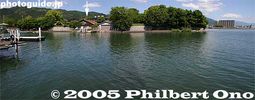
Mihogasaki harbor, Otsu. The arrow points to the boat house.Mar 13, 2007
|
|

"Umi no Ko" (Child of the Lake) Lake Biwa training boat for kidsMar 13, 2007
|
|

"Umi no Ko" (Child of the Lake) Lake Biwa training boatThe bow of Shiga Prefecture's "floating school." The name of this boat was obviously taken from the song. The boat is owned by Shiga Prefecture and used to educate elementary school kids about the lake. Since 1983, this ship has been serving as a floating school for kids where they stay overnight and spend two days conducting experiments to learn more about the lake. Picture was taken at Hikone Port.Mar 13, 2007
|
|

About the song and rowing route... この歌について(日本語解説)Shiga Prefecture's most famous and beloved song is called Biwako Shuko no Uta (琵琶湖周航の歌) or "Lake Biwa Rowing Song." I have rendered this song into both pictures and English, according to my own imagination and interpretation.
Please see this page for a full explanation: https://photoguide.jp/txt/Lake_Biwa_Rowing_Song
First composed in 1917 by a bunch of college students from Kyoto, the song has been recorded by many famous Japanese singers and groups. In 1971, it became a major nationwide hit with singer Tokiko Kato's rendition. Today, the song remains a favorite among choir groups in Japan, and a choir singing contest is held for the song every June (since 1997) in Imazu, the birthplace of the song in the northwestern corner of Lake Biwa.
Shiga Prefecture also has stone monuments dedicated to each of the six verses. There's even a museum (Biwako Shuko no Uta Shiryokan) in Imazu dedicated to the song. Okaya city on the shores of Lake Suwa in Nagano Prefecture, the birthplace of the song's composer, Taro Oguchi (小口太郎) (1897-1924), also has a song monument and bronze statue of him.
Mar 13, 2007
|
|

The photo above shows part of the stone monument for the first verse of the song. It reads "Ware wa Umi no Ko" (We're children of the lake). [url=http://photoguide.jp/txt/Lake_Biwa_Rowing_Song]More info about Lake Biwa Rowing Song here.[/uThis is the song's first and most famous line. The monument is in a small park near the former boathouse in Mihogasaki pier. The photo has been digitally altered (the colors are not real).
I visited and photographed all the places mentioned in the song as well as all the song monuments in Otsu, Omi-Maiko, Imazu, Chikubushima, Hikone, Chomeiji, and Okaya (Nagano). I also created some digital images to match the scenes mentioned in the song.Mar 13, 2007
|
|

Printable map and directions to all song monuments. Google map 歌碑の案内地図Also see this Google map: Google mapMar 10, 2007
|
|
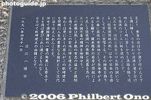
Message plaque, Verse 6 Song Monument, ChomeijiMar 10, 2007
|
|

Rear of Verse 6 monument. Next to the main stone is a plaque for the entire lyrics.Mar 10, 2007
|
|

Plaque for entire lyrics, Verse 6 Song Monument, ChomeijiJapanese lyrics of the entire song consisting of 6 verses.Mar 10, 2007
|
|

Verse 6 Song Monument, Chomeiji Port. Built in 1998. 六番の歌碑。長命寺(バス停のすぐそば)Near the Chomeiji bus stop. It faces the pier. This monument has the most number of stones. But only two of them are used.
See more photos of Chomeiji Temple here.Mar 10, 2007
|
|

Kyoto University Rowing Club visit the Verse 6 monument during their during their annual Lake Biwa rowing trip. 写真/尾城徹雄Chomeiji is one of their overnight stops during their 3-day rowing trip. Mar 10, 2007
|
|

Close-up of main stone monument where Verse 5 is written. 2005年10月に除幕されて一番新しい歌碑。800万円の寄付金で建てた。Sharp arrows buried deeply, way into the ground.
Abundant summer grasses, a moat still remains.
Standing in an old castle, all alone oneself.
Hira and Ibuki too, only but a dream.
Ya no ne wa, fukaku uzumorete
Natsukusa shigeki, hori no ato
Kojo ni hitori, tatazumeba
Hira mo Ibuki mo, yume no goto
矢の根は 深く埋もれて
夏草しげき 堀のあと
古城にひとり 佇めば
比良も伊吹も 夢のごとMar 10, 2007
|
|

Verse 5 Song Monument, Hikone Port 五番の歌碑。彦根港The left stone is inscribed with the entire song, and bigger stone on the right has the lyrics for verse 5. There is also another stone which shows a map of the lake and rowing route. The monument is now encroached by tall grass and weeds.
This song monument was built in Oct. 2005 at a cost of 8 million yen (gathered through donations). With this, now all six verses each have a song monument. This one is next to Hikone Port where you board the boat to visit Chikubushima or Takeshima.Mar 10, 2007
|
|

Biography of Oguchi TaroMar 10, 2007
|
|

The first verse is wriiten, but the first line about Chomeiji being the 10th temple in the Saigoku Pilgrimage is omitted.Chomeiji is the 31st temple in the Saigoku Pilgrimage, not the 10th temple as sung in the song.Mar 10, 2007
|
|

Verse 6 Song Monument facing Chomeiji pierMar 10, 2007
|
|

Verse 5 Song Monument facing Hikone Port. See more photos of Hikone here.The three-stone monument is in a good location facing Hikone Port. This photo was taken soon after the monument was built. Over the years, wild grass or weeds have invaded the monument plot.
Mar 10, 2007
|
|

Main stone of Verse 6 Monument 問題の「西国十番」が刻んでいない。Saigoku pilgrimage, Chomeiji.
Dispel this world's impureness, very faraway.
Golden waves on which we weave, rowing all we can.
Tell us my friends your stories, with your fervent hearts.
Saigoku Juban, Chomeiji
Kegare no utsushiyo, tooku sarite
Kogane no nami ni, iza kogan
Katare wagatomo, atsuki kokoro
西国十番 長命寺
汚れの現世 遠く去りて
黄金の波に いざ漕がん
語れ我が友 熱き心Mar 10, 2007
|
|

Verse 5 Song Monument, the third monument showing the rowing route, Hikone PortThe monument's third stone shows a map of the lake and rowing route. It also states the dates when all the song monuments were built in Shiga.
See more photos of Hikone here.Mar 10, 2007
|
|

Chikubushima boat dock. The Verse 4 Song Monument on can be seen on the left.Mar 10, 2007
|
|
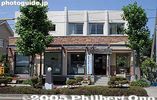
The old Biwako Shuko no Uta Shiryokan (Lake Biwa Rowing Song Museum), Imazu 琵琶湖周航の歌資料館、今津町This museum dedicated to this song opened in April 1998 in Imazu. It is a 3-min. walk from Omi-Imazu Station on the JR Kosei Line. Closed in March 2020 and moved to a new building.
Hours: 9 am to 5 pm, closed Mon. (open if Mon. is a national holiday, and closed on Tue. instead)
Free admission.Mar 10, 2007
|
|
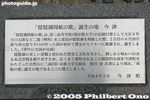
Song Monument plaque, Imazu. It explains about how the song was created in Imazu.Mar 10, 2007
|
|

Chikubushima island and snowly Mt. Ibuki in the background.Mar 10, 2007
|
|

Song monument at Imazu Port.Mar 10, 2007
|
|

Imazu Port and song monument in winter snow.Mar 10, 2007
|
|

Verse 3 Song Monument is written with Verse 3.We drift from wave to wave, straying aimlessly.
On shore we see red fire, brings back memories.
With our sights set nowhere, rolling with the waves.
Today is Imazu or, Nagahama huh.
Nami no mani mani, tadayoeba
Akai tomaribi, natsukashimi
Yukue sadamenu, nami makura
Kyo wa Imazu ka, Nagahama ka
浪のまにまに 漂えば
赤い泊火 懐かしみ
行方定めぬ 浪枕
今日は今津か 長浜か Mar 10, 2007
|
|

Song Monument, Imazu. Looks like red fire, but it's also the shape of Imazu town. (The background shows the old Imazu Port building.)Directions: From Omi-Imazu Station on the JR Kosei Line, get out the east exit and walk on the main road toward the lake. You will soon see the Biwako Shuko no Uta Shiryokan song museum on the left. Be sure to visit this museum too. Walk further toward the lake and you will see Imazu Port. Near the water, you can see the "red fire" song monument. On the very end of the pier, and you can see the lamp monument. (The pier might be closed off if there is no boat, so you may have to ask permission to walk on the pier.) Omi-Imazu Station also has a tourist information office where you can obtain directions and a map.Mar 10, 2007
|
|

Imazu Port. Verse 3 Song Monument is at the end of the dock. The same dock used by boats going to Chikubushima. The dock is usually closed.Chikubushima island and Mt. Ibuki can be seen.Mar 10, 2007
|
|

Verse 3 Song Monument Mar 10, 2007
|
|

Old photo of Verse 2 Song Monument in Omi-Maiko. The tree was cut down and lyrics later painted white.Mar 10, 2007
|
|

Near the Verse 1 Song Monument is another stone monument engraved with the words of the entire song.Mar 10, 2007
|
|

Small park where the Verse 1 monument is located.This monument is near the boat house in Mihogasaki, a stone's throw from Hama-Otsu. It was built in 1973 as the first monument for the song.
This little park is actually off-limits and you're not supposed to enter it, for some reason. On the left side of the picture is another stone monument hidden by brush. It is engraved with the entire song. In the background, you can see the roof of the boathouse.Mar 10, 2007
|
|

Back of Verse 1 Song Monument, Otsu (Mihogasaki)Directions: From JR Otsu Station, take a bus to Mihogasaki. It's about 10 min. Or you can easily walk it from Hama-Otsu Station. Just walk on the main road toward the race boat arena. There will be a small marina on the right. Right after passing the marina, turn right into the small road. There will be a small park on the right. The monument is there. There are two stone monuments. It might be roped off and you're not supposed to enter the park. While you're there, walk around the marina and see the boathouse with the cherry blossom logo with three stripes. That's the logo of the school and the place where the boys left for the rowing trip in 1917. Otsu Station also has a tourist information office where you can obtain directions and a map.Mar 10, 2007
|
|

Verse 1 Song Monument, Otsu (Mihogasaki). In 1973, this was the first monument built for the song. The song's first and most famous line, "Ware wa Umi no Ko" is written. 一番の歌碑。大津市三保ケ崎。This monument is near the boat house in Mihogasaki, a stone's throw from Hama-Otsu.
われは湖の子 さすらいの
旅にしあれば しみじみと
のぼる狭霧や さざなみの
志賀の都よ いざさらば
Ware wa Umi no Ko, sasurai no
tabi ni shiareba, shimijimi to
Noboru sagiri ya, sazanami no
Shiga no Miyako yo, iza sarabaMar 10, 2007
|
|
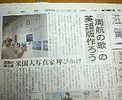
In the news: Article in Asahi Shimbun, Dec. 11, 2005 Sunday morning edition. The headline reads, "Let's Make an English Version of the Rowing Song."A reporter for the Asahi Shimbun in Otsu thought my project was worthy enough for a story in the Dec. 11, 2005 Sunday morning edition of the newspaper's Shiga News page (distributed in Shiga Prefecture).
The headline reads, "Let's Make an English Version of the Boat Song." It describes my project to create an English version of the song and have it sung at the annual choir contest in June in Imazu (which didn't happen in 2006). It also quotes people in Imazu who welcome my project for an English version.
2005年12月11日の朝日新聞朝刊の滋賀版に僕の写真展と歌の英語化を大きく掲載されました。あんなちっぽけな写真展で注目されるなんて想像もつきませんでした。
英語版を2006年6月3日に発表したあとも各新聞紙の滋賀版で大きく報道されました。詳細はここ。Dec 12, 2005
|
|

About Taro Oguchi.The song was written as a collaboration among boatmates, but Taro Oguchi (小口太郎) (1897-1924) is credited as being the main song writer. He was born in 1897 (Meiji 30) in Minato-mura village, now part of Okaya city on the shores of Lake Suwa in Nagano Prefecture.
He grew up in a loving and respected family and demonstrated an early talent for writing, music (violin and shakuhachi), and sports (judo, skiing, skating). Since he was the eldest son expected to take over the family home, there was opposition for him to go away for college. However, his father was persuaded to allow Taro to apply for college at the elite No. 3 High School (later to become Kyoto University). It was one of nine college-level schools in Japan, the No. 3 school being one of the most elite.
Contrary to family expectations, Taro passed the entrance exam, went school in Kyoto in 1914 and joined the rowing and speech clubs. In 1917, he wrote the famous song about Lake Biwa which first went public in 1918.
After the rowing trip in June 1917, school started in September and they had the usual student welcoming event where the school clubs would try to recruit new members. The music club gave a performance and boatmate Taniguchi (who suggested the Water Lilies melody for the song) also sang the Lake Biwa Rowing Song. He had such a beautiful voice that the boating club got several new members who were taken by the song. However, they quickly regretted joining the rowing club after being subjected to harsh training and practice.
The song itself was never considered to be a masterpiece by the boating members, even Oguchi himself. It was just a dormitory song written informally. For example, there's the famous error about calling Chomeiji the 10th Temple of the Saigoku Pilgrimage when it is actually the 31st temple. None of the rowing members ever told their family about the song either. Oguchi's parents found out that their son wrote the song only after he had passed away.
Oguchi also wanted to use a different melody for his words, a song called "Nara no Miyako" 寧良の都. It is obvious that this song melody was too long for his lyrics, but since he had musical composition talents, it looked easy to slightly modify the song to fit the lyrics perfectly. Alas, this was not to be as the song gained much love and fame while being based on the Water Lilies melody.
He graduated in 1919 and furthered his studies at Tokyo Imperial University (now University of Tokyo) in the science department. In 1921, he invented the wired and wireless multiplex telegraph and telephone system which was patented in eight countries. He was an extremely bright young man with a promising future.
In 1922, he entered the university's aeronautical research institute as a researcher. However, his life soon took a downturn from 1923 when he received a military conscription notice. A love interest for marriage also did not work out as desired. His physical health deteriorated and he died the following year in 1924 at age 26.Nov 30, 2005
|
|
|
|
|
|